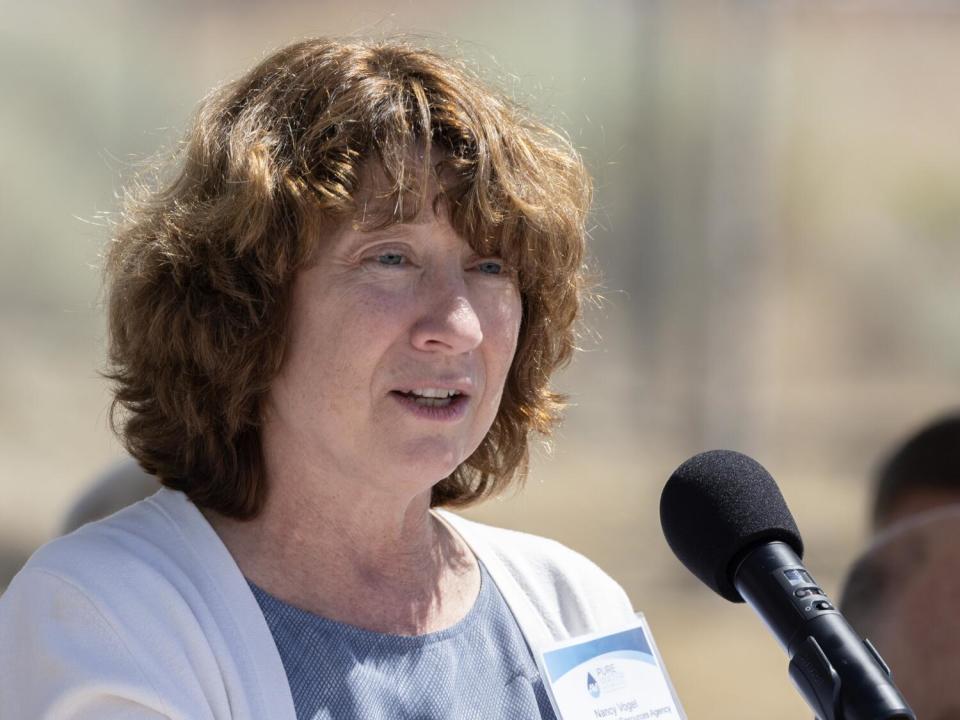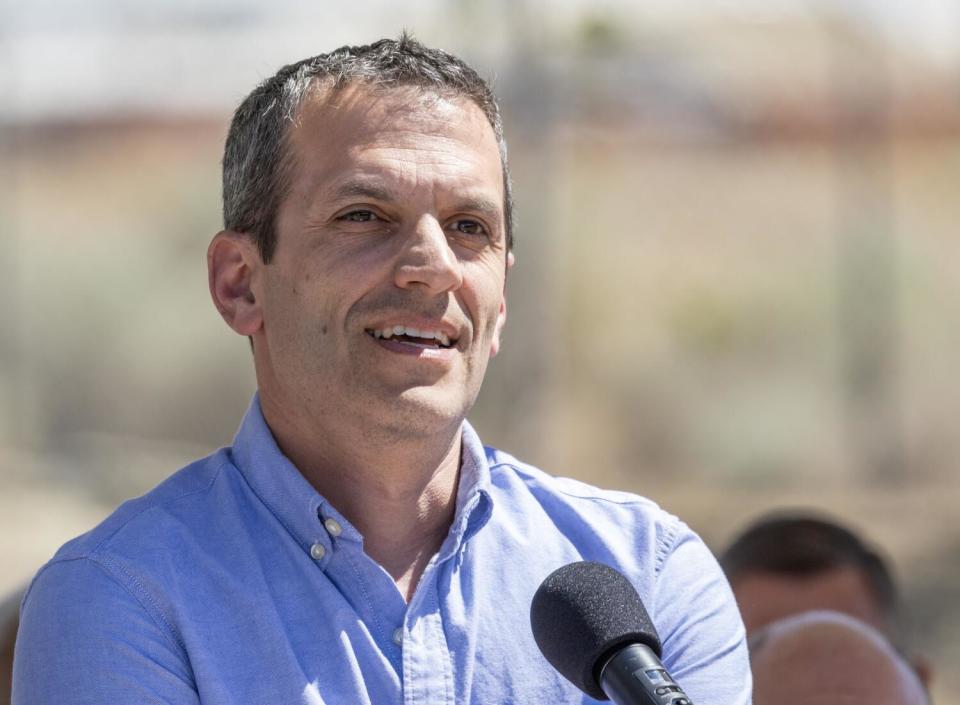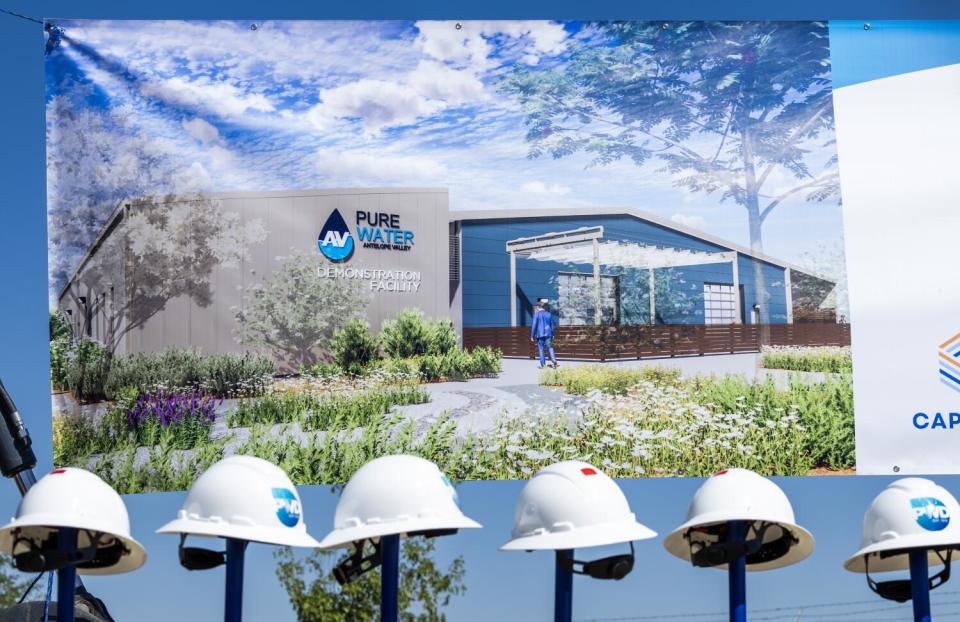Carbon-capture projects launch in Los Angeles County as CO₂ levels reach global records

As soaring fossil fuel emissions continue to heighten global warming, multiple projects seeking to remove carbon dioxide from the air have been launched across Los Angeles County — an effort that project developers say is destined to make Southern California a global leader in climate adaptation.
Under a blazing Palmdale sun recently, state and local officials gathered to break ground on one such project, a first-of-its-kind wastewater treatment facility that also removes CO₂ from the atmosphere.
Project Monarch, a public-private partnership between the Palmdale Water District and the climate technology company Capture6, will not only provide residents with new water supplies, but will also help California achieve its goals of 100% renewable energy and carbon neutrality by 2045, according to Nancy Vogel, deputy secretary for water at the California Natural Resources Agency.

“The cornerstones of California’s climate change leadership are electrifying our economy and decarbonizing our grid, and we set ambitious goals for that,” Vogel told the crowd Thursday. However, “we can’t get there by simply reducing our emissions. We have to start capturing existing emissions.”
When completed, Project Monarch and its wastewater component, Pure Water Antelope Valley, will purify up to 4.5 million gallons of water each day and capture 25,000 tons of atmospheric CO₂ each year. (The typical gasoline-powered automobile spews 4.6 tons of carbon each year, according to the Environmental Protection Agency.)
Carbon dioxide, which comes from the extraction and burning of fossil fuels, is one of the main drivers of climate change. Yet global CO₂ emissions continue to reach new highs, with May readings from the Mauna Loa Observatory in Hawaii showing the largest two-year jump in peak CO₂ levels on record. Current CO₂ levels in the atmosphere are 427 parts per million and counting.

Efforts to reduce those emissions, as well as remove CO₂ from the atmosphere, have been bolstered by the California Air Resources Board and the Intergovernmental Panel on Climate Change — both of which have promoted the use of so-called direct air capture technologies.
“Pure Water will enable us to be more drought-proof, have local control of our water and improve our groundwater quality and quantity,” said Dennis LaMoreaux, general manager of the Palmdale Water District. “Having the ability to have Project Monarch capture carbon is a win-win for everyone.”
Capture6 has received an $8-million grant from the California Energy Commission. Meanwhile, the Biden administration has announced more than $3.5 billion in investments in direct air capture projects across the nation.
Read more: Earth breaks heat and CO₂ records once again: 'Our planet is trying to tell us something'
But the Palmdale project isn’t the only new carbon-capture development in L.A. County. On Friday, officials from CarbonCapture Inc. gathered in Long Beach to introduce the first commercial-scale U.S. direct air capture, or DAC, system designed for mass production.
The unit, which resembles a shipping container, can remove more than 500 tons of atmospheric CO₂ per year.
“What CarbonCapture Inc. is doing with its modular approach to direct air capture, and efforts to ramp up production of the technology and bring down costs, underscores the indispensable role of the private sector in developing and deploying carbon management at a scale needed to achieve a clean energy and industrial future,” said Brad Crabtree, the U.S. Department of Energy’s assistant secretary for fossil energy and carbon management, in a statement.
The L.A.-based company also announced that it will mass-produce up to 4,000 of its DAC modules annually at a new facility in Mesa, Ariz.
It joins similar efforts from L.A.-based Captura, which is working to remove CO₂ from the upper ocean; L.A.-based Avnos, which produces water while capturing carbon; and L.A.-based Equatic, which is working to remove atmospheric CO₂ using the ocean.
“The rest of the world knows that if Los Angeles, and California more broadly, is able to do this, then other places will too,” said Edward Sanders, chief operating officer at Equatic.
Read more: New scientific interventions are here to fight climate change. But they aren't silver bullets
Equatic was born out of UCLA’s Institute for Carbon Management, where researchers found a way to combine CO₂ removal with hydrogen generation, “addressing both legacy and future emissions in a single process,” the company says.
The company’s San Pedro facility pumps seawater through a series of electric plates that separate the water into hydrogen and oxygen as well as acidic and alkaline streams of liquid. The alkaline, or base, stream is exposed to the atmosphere, where it mineralizes CO₂ into carbonates that are then dissolved and discharged back into the ocean for permanent storage, operators say. The procedure meets all existing coastal regulations, according to Sanders.
Additionally, the hydrogen produced by the process is carbon-negative, making it a source of renewable energy that can be used to fuel the CO₂ removal process or sold to other users, he said.
Equatic announced this month that it will partner with a Canadian carbon removal project developer, Deep Sky, to build North America’s first commercial-scale ocean-based CO₂ removal plant in Quebec, following the success of its effort in Los Angeles as well as another facility in Singapore. While the San Pedro facility can capture about 40 tons of CO₂ per year, the Quebec facility will capture about 100,000 tons per year, Sanders said.
“As important as it is do this globally, we recognize that there’s a lot happening in Los Angeles, and being able to bring people through and see it — to walk in and see one of these plants, to literally hold the carbon that we’ve taken out of the atmosphere in their hand — that’s really important,” he said.
Read more: The planet is dangerously close to this climate threshold. Here's what 1.5°C really means
Although the various projects represent a carbon-capture boom in Southern California, they each use different strategies.
Project Monarch’s carbon-capture process begins with Palmdale’s new wastewater treatment facility, which will purify recycled water from L.A. County for potable reuse. The purification procedure removes bacteria, viruses and other harmful pathogens from the water, but it also comes with a byproduct: a salty solution known as brine. The district had planned to store the brine in open-air ponds, where it would sit, stagnant, until evaporation.

Instead, Capture6’s technology will run the brine through a series of steps that convert it first into sodium hydroxide, which naturally strips CO₂ from the atmosphere, and ultimately into sodium carbonate, a mineralized form of captured carbon. The resulting rocks are dissolved in water that can be reused directly in the water treatment process, or injected into aquifers or other non-potable subsurface formations for permanent storage.
“This facility has the potential to demonstrate — both in the state and country and potentially globally — that we can build a carbon-negative water treatment facility,” said Ethan Cohen-Cole, chief executive of Capture6.
Cohen-Cole said the project will run on grid energy, which is becoming increasingly renewable in California. He added that L.A.’s proactivity and innovation on water and energy issues made it a natural fit for the project, which will be the first of four such endeavors around the world.
“California looks a lot like a number of other water-stressed places in the world that also are motivated to decarbonize,” he said. “Those two together make it a great place to be.”
Read more: Will storing CO2 in old oil fields slow global warming? First California plan nears approval
The carbon-capture process is not without downsides, however. It can be expensive and energy-intensive, and there is still much active research about the best means and methods of storing the carbon.
Many companies sell carbon-removal credits to other companies, such as Meta, Chase, McKinsey and Boeing. While Capture6, Equatic and CarbonCapture boast high-integrity credits, the carbon credit marketplace in general has also been criticized for allowing polluters to continue producing emissions while “greenwashing” their reputation.

In the same vein, experts say the rapidly growing ability to remove CO₂ from the atmosphere should not equate to permission to keep emitting. The Intergovernmental Panel on Climate Change estimates that between 6 billion and 12 billion tons of CO₂ will need to be removed annually in order to limit global warming to 1.5 degrees Celsius — or 2.7 degrees Fahrenheit — by midcentury.
“Even if we were to reduce emissions to zero tomorrow, which isn’t happening, we would still need to remove from the atmosphere billions of tons of carbon dioxide,” said Sanders, of Equatic. “But what we don’t want to do is get caught short in five or 10 years’ time, and not have any technology to either remove the stuff that cannot be abated, or to clean up the pollution from the last 120 years that’s in the atmosphere.”
Cohen-Cole shared similar thoughts after he and other officials gathered with hard hats and shovels to break ground on Pure Water and Project Monarch, due to be operational in 2025.
“This only works if we prioritize reductions of emissions,” Cohen-Cole said. “I would never argue that we should be using carbon removals in the absence of reductions — and we’re inspired by the fact that both California and the IPCC say that we need to do this now. We have no choice.”
This story originally appeared in Los Angeles Times.


